To the coastal Tlingit people, home is the narrow mainland coast, islands, bays and fjords of southeast Alaska. The people reside where the land meets the sea, building their villages on narrow rock beaches wedged between the tidewater and the dense forests rising into lofty mountains, an area of human occupation for the last 10,000 years. Heavy rainfall creates a luxurious rainforest environment and a temperate climate.
Tlingit villages have always faced the sea. The peoples' lives revolve around the harvest from the sea outside the front door and from the forests and rivers outside the back door. The waters of southeast Alaska provide one of the richest maritime environments in the world. As the Tlingit people make their seasonal rounds, they catch fish and sea mammals and collect shellfish and sea plants.
Bounty From the Sea
The Pacific coast gave rise to many different cultures, each with their own language, beliefs, designs and routines. However, their dependency on the sea united them all. All villages hugged the water's edge; all houses faced toward the sea. The waterways were the main highways; a long row of canoes on the beach in front of a village was evidence of the people's marine mobility.
Many Northwest Coast Indian myths, songs, dances and ceremonies have their foundation in the sea, its spirits, the underwater world, or the characteristics of the fish. Creatures of the sea became family crests and were incorporated into everyday life—carved into objects, painted on possessions, tattooed on the body, and woven into baskets.
The beaches of the sea produce an abundance of shellfish, edible invertebrates, and seaweeds. The sea itself provides salmon, halibut, herring, cod, kelpfish, red snapper, dogfish, flounder, smelt, octopus and many others.
The Northwest Coast Indians are totally adapted to living with the unpredictable ocean as a neighbor. They know the ebb and flow of the tides, the currents, and the changing winds that turn the water from a gentle ally to a violent, cruel enemy. To this day, when fishing and preparing fish, Tlingit people continue to practice respectful observances. Your food comes from the land and sea. To abuse either may diminish its generosity, admonishes Tlingit elder Walter Soboleff.
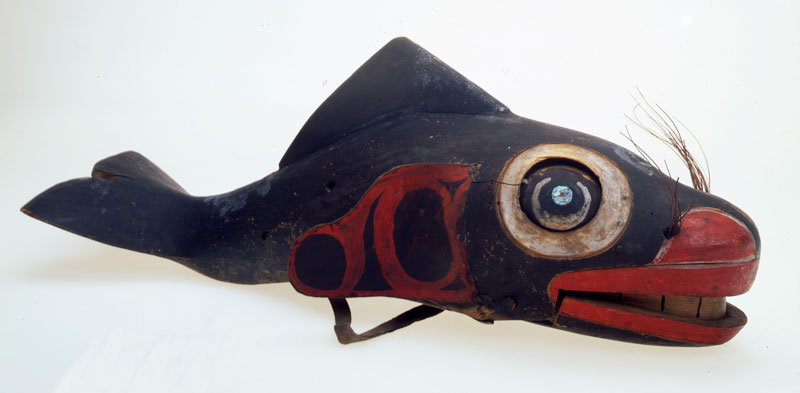
Haida?, British Colombia, Canada, collected 1904
Cedar?, raw and tanned hide, sea lion (Eumetopias jubatus) whiskers, abalone (Haliotis sp.) shell, iron, mineral paints; L 51.0 x W 18.1 x H 16.3 cm; 3178-38
This carving of an orca, or killer whale, was worn on the head by a dancer, who could roll its eyes or move its lower jaw during a theatrical performance. No Northwest Coast tribe actively hunted killer whales, the largest members of the dolphin family.
In general, Tlingit people did not hunt whales. Only the southern peoples of the west coast of Vancouver Island and the Washington Olympic Peninsula hunted these animals in large ocean-going canoes.
Pacific Salmon
The Pacific salmon is preferred above all other fish by the Tlingit and other Northwest Coast peoples. Every year five different species of salmon follow one another in succession, journeying from the sea to swim upriver.
When the [salmon] run reaches its destina-
tion, it’s like a red blanket,
solid,
with sockeyes….
That whole river is a red blanket,
solid,
mature,
mature sockeyes, eiiih!!!
Boiled fish.
-Horace Marks, Tlingit, 1984
There are five species of Pacific salmon found in North America: sockeye, pink/humpback, king/chinook, Keta/chum, and silver/coho. Their range extends north to the Arctic Ocean and as far south as Monterrey Bay in Northern California.
The upstream odyssey of the salmon is one of nature's greatest spectacles. Salmon are unique among the fishes because of their anadromous life cycle--they hatch in freshwater, spend part of their lives in the ocean, and are driven by a homing instinct to their stream of birth to spawn, or reproduce. The long journey from sea to birthplace is marked by a series of remarkable transformations, which occur in each stage of the salmon life cycle.
Salmon was the most valuable natural product of the Northwest Coast as well as the staple food of the Tlingit people. The supply of salmon harvested from the annual runs was abundant enough to sustain one of the most heavily populated areas of Native North America.
The Tlingit people consider salmon a sacred people as well as a valuable resource. They show their respect by greeting the fish with songs, prayers, and special ceremonies. After catching and eating salmon, the Tlingit return the bones to the ocean. The bones then come back to life as more Salmon People.
According to Tlingit belief, the Salmon People are a plentiful and powerful tribe that lives somewhere in the ocean. Salmon Country is surrounded by constantly opening and closing rings through which the Salmon People jump quickly to preserve their clean silver sides. Those that are caught in the rings are cut or marked, accounting for the stripes on their sides. Salmon Boy is a Tlingit legend that demonstrates the importance of salmon to this native culture.
Salmon are believed to travel in invisible canoes. The chiefs of the different families stand in the stern to direct their movements landward. When spring comes, a great meeting is called, and all start at once for their streams, resulting in the annual migration home from the sea.
One of nature's great spectacles, the life cycle of the Pacific salmon begins and ends in the gravel beds of a stream, river, or lake where an adult female salmon deposits hundreds of eggs. Before this event can occur, however, the salmon must undergo a series of transformations that culminate in an orgiastic celebration of instinct and nature's will to survive.
- A Rocky Beginning
Although an adult female may deposit as many as 1,200 eggs a day in the gravel nest she digs, only a small percentage of these survive to hatchling stage. Some are swept away by the current, and others are eaten by predatory fish such as sculpin, resident trout, and Dolly Varden char.
Those salmon that survive the embryonic stage emerge from their eggs as tiny, inch-long hatchlings called alevins. For several weeks or months the alevins remain in the gravel, still attached to their yolk sacs that provide nutrients and oxygen. Once the hatchlings emerge from the gravel and lose their yolk sacs, they are called fry.
- "Parr" for the Course
Within months, the juvenile salmon have graduated to the next stage of development, called the parr or fingerling stage. Fingerlings develop dark-colored vertical bars, called parr marks, that blend in with the gravel and help camouflage them from predators.
The parr remain in the lake or river for one or more years or migrate immediately to salt water, depending on the species. Pink and chum salmon migrate to the ocean shortly after emerging from the gravel; sockeye rear in lakes, chinook in streams, and coho in streams and backwater areas.
- From Smolt to Shining Sea
When the parr are ready to leave freshwater and migrate to the sea, they undergo a special process called smolting, and are then called smolts. Their bodies turn silver and complete a series of physical changes that prepare them for the transition from freshwater to saltwater.
Predators, turbine blades, and dams are among the dangers that await along the path to the sea. The smolts swim at night and hide during the day. For several weeks or months, the smolts stay in freshwater bays where the river meets the ocean. Eating tiny shrimp, other crustaceans, and the young of other saltwater fish, they grow very quickly before disappearing into the ocean.
- In Neptune's Realm
The distance and direction a salmon travels once it reaches the sea varies depending on the species. Many salmon travel along with ocean currents in circular routes. Some wander as far as 2,000 miles from the stream of their birth; others stay closer to home. On a diet of small fish, the salmon grow into adults weighing between 25 and 100 pounds.
Salmon can be food for bigger animals like tuna, seals, dolphins, and whales. However, a salmon's coloration helps it to avoid these predators. Salmon feed mostly at night when it is harder for predators to see them.
Depending on the species, maturing salmon spend one to seven years in the ocean before returning to their ancestral breeding grounds to spawn.
- It's a Bird! It's a Plane! It's a Salmon?
After using their sense of smell to locate the streams in which they were spawned, salmon begin a transformation that rivals that of any superhero. Their silver color explodes into greens, reds, and purples that help members of the same species identify each other. Males develop a hump and a hooked jaw called a kype. Clearing 6-foot waterfalls in a single bound, salmon may travel as far as 2,000 miles upstream. Most adult salmon do not eat once they return to fresh water—their only objective is to spawn.
The female sweeps gravel away with her tail, creating a broad, shallow nest and attracting males who fight for the right to breed. After spawning, the adult salmon die, leaving a new generation developing under the gravel.
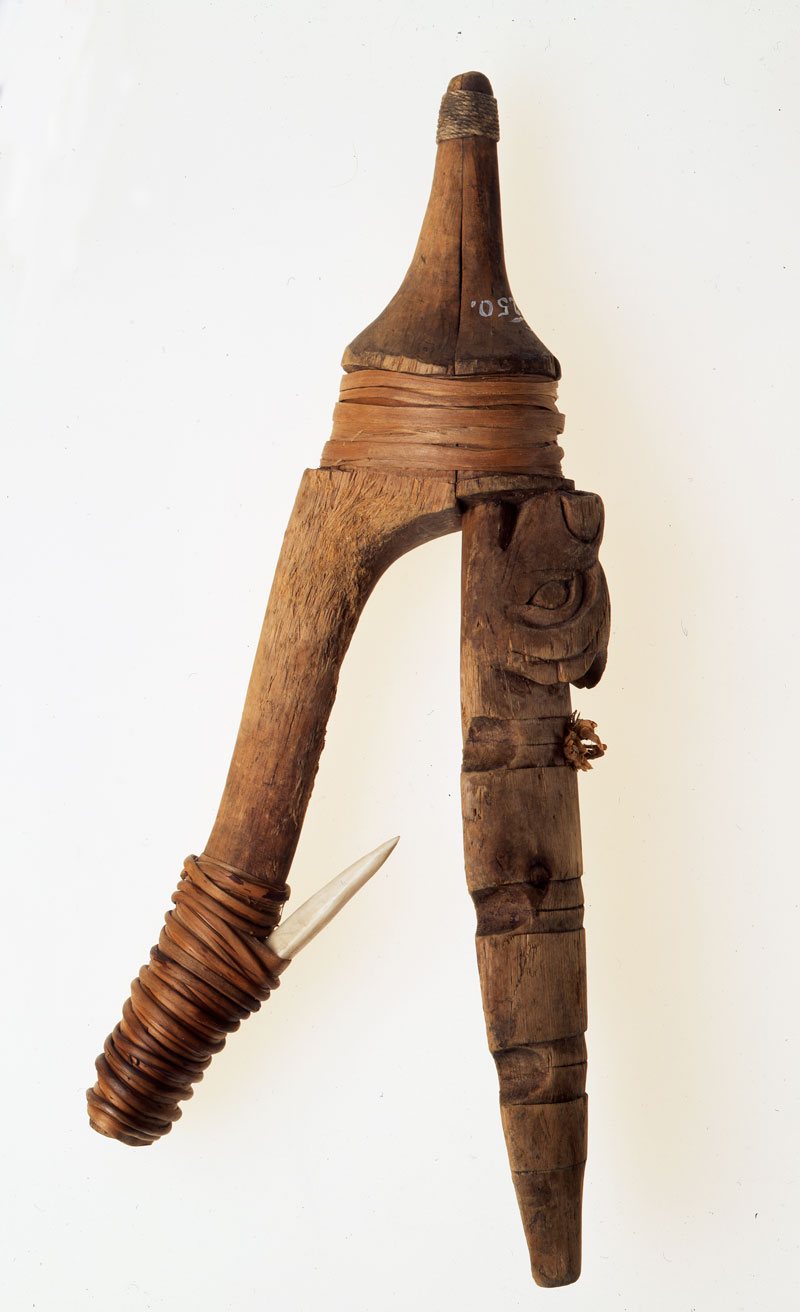
Tlingit peoples, Alaska, pre-1898
Yellow cedar (Chamaecyparis nootkatensis) or Sitka spruce (Picea sitchensis), red alder (Alnus rubra) or Pacific yew (Taxus brevifolia), Sitka spruce root (Picea sitchensis), unidentified bone, cotton cord; L 27.8 x W 11.5 x H 4.8 cm; 638-13
Pacific Halibut
Halibut fishing requires the greatest ritual attention because it is the most dangerous fishing activity. The halibut grows to be the largest and most powerful fish in the region The Pacific halibut looks like a fish swimming on its side along the bottom of the sea, except both eyes are on the upper side. It belongs to the flounder family and is by far the largest of all flatfish. Although a halibut can weigh up to 600 pounds, the specially engineered Tlingit hook was designed to catch a fish no larger than a man could haul into his canoe.
In the past, fishermen used a specially carved hook, weighted by a rock and suspended downward, so the halibut would see its decoration and be influenced by it. Today, Tlingit fishermen still believe that success in fishing depends on the willingness of the fish to make itself available to humans. In selecting the image to carve on the hook, fishermen often chose a powerful creature, perhaps itself a good fisher. Its spirit would entice the fish to the bait.
The fisherman gave his halibut hook a personal name and carved a figure on it. Then addressing the hook, he said something like, Go down to halibut land and fight! The carved image on the hook endowed it with power to lure the fish.
On this hook, the wood carver created a land otter. This is an animal that swims like a fish, has webbed feet like a duck, and according to Tlingit mythology, was once a human being. As a supernatural being, the land otter steals the spirits of humans who have drowned and entices the living, especially in times of physical weakness.
Sea Mammals
Although the sea offers a bounty of animal life to the people of the Northwest Coast, the rugged terrain of the coast and the rough waters make hunting a challenge. Faced with the challenges of making a life in this environment, the Tlingit people developed skills that enabled them to reap the harvest of their most accessible resource: the sea.
Seals and sea lions were the most valuable sea mammals to the people of the Northwest Pacific Coast. Symbols of wealth and plenty, they provided food, clothing and medicines. In addition, skins were fashioned into floats and bags, the intestines into string and bow-strings, and the bladders into containers.
The Northern Pacific is home to a number of different species of sea mammal. The harbor seal (Phoca vitulina) lives everywhere along the coast and enters many rivers. The northern fur seal (Callorhinus ursinus) is an offshore migrant. The northern sea lion (Eumetopias jubatus) ranges along most of the coast, frequenting both offshore islands and estuaries. The smaller California sea lion (Zalophus californianus) and large northern elephant seal are found in the area as well.
Most Pacific Coast peoples admired whales from afar. Hunting these mammals required both great skill and endurance. The whale was never actively hunted by the Tlingit; however, beached whales were an important resource. A single whale could provide a village with blubber and skin for food, bone for tools, sinew for rope, and oil for lamps.
Before commercial whaling, the most common species of larger whales were the humpback whale (Megaptera novaeangliae), which often entered straits and sounds, and the gray whale (Eschrictius gibbosus), which migrated seasonally just off the outer coast.
The orca or killer whale (Orcinus orca), once commonly called blackfish, is present all along the coast and abundant in waters from Alaska to Puget Sound. Killer whales were a clan symbol for many tribes.
Sea Otters
The sea otter (Enhyda lutris) was once very common all along the outer coast. With the Europeans' arrival in 1780, their pelts became the most sought-after trade product, resulting in the animal's near extinction.
Unlike the other members of the amphibious otter family, the sea otter (Enhydra lutris) lives the majority of its life in the water. The sea otter, the largest member of the weasel family, ranges along the Pacific coast from Alaska to California.
Nature has equipped the sea otter with many adaptations for a life in the ocean: tightly-packed water-repellant fur; a long, strong, and flexible body built for vigorous swimming; flipper-like hind feet and webbed paws to propel it through the water; and ears and nostrils that close underwater.
An adept underwater hunter, the sea otter has a very rapid metabolism and must eat frequently, often four times each day. Its stiff whiskers are sensitive to water turbulence and alert the otter to nearby prey, which it snatches in its strong jaws. An otter eats what is readily available and easy to catch, including fish, frogs, crayfish and crabs. The sea otter's large, rounded molars are perfect for crushing sea urchins, abalone, and mussels, which it pries from rocks with its forepaws.
When it comes to handling objects, the versatile otter is a master of manipulation. Other than primates, otters are the only mammals that use tools in obtaining food. To dislodge abalone underwater, an otter grasps a stone between its forepaws and bangs it against the edge of an abalone shell. It may take three or more dives to successfully dislodge the tasty abalone from its shell. However, an otter may use the same stone over and over again.
Once it has obtained its catch, the sea otter brings its food to the surface. The otter places a stone on its chest and uses it as an anvil on which to open mussels, clams, and other shellfish. Food is carried to the surface in the otter's forepaws and the stone is placed in a flap of skin under its arm. The otter may roll in the sea between bites to clean itself of debris and keep its fur clean.
The fur coat which was perfect for a life at sea also nearly cost the species its life. The sea otter was hunted close to extinction for its pelt until it was protected by one of the first international endangered species agreements in 1911.
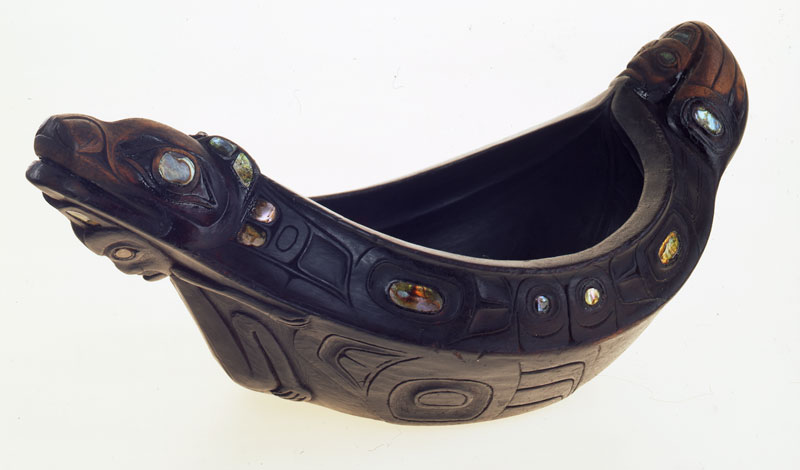
Tlingit peoples, Alaska, collected 1904
Red alder (Alnus rubra), abalone (Haliotis sp.) shell; L 32.0 x W 18.0 x H 12.2 cm; 3178-63
This feast bowl is carved in the shape of a seal, complete with its head, flippers, and body curve. It was used on special occasions to serve eulachon or seal oil. Oil rendered from the eulachon, a small slender fish, is a prized condiment that is mixed with fish, berries, and other foods. It is also a nutritious dietary supplement, notable for its high vitamin A content.
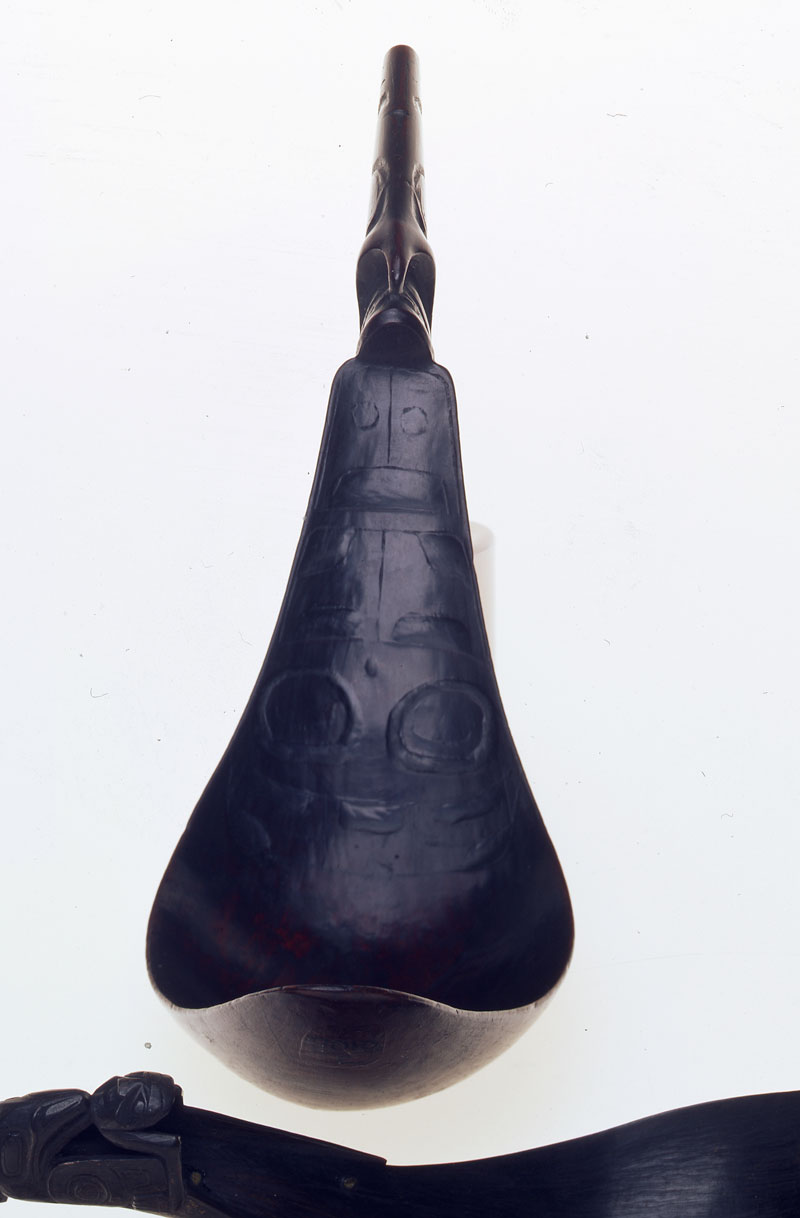
Tlingit? Peoples, Alaska, mid 1800s, purchased 1876
Mountain goat (Oreamnos americanus) horn, brass?; L 25.0 x W 6.4 cm; 9010-3, gift of Oliver McClintock
Special spoons made from steam-bent mountain goat (or sheep) horn or wood were brought out to use at great feasts. The handles were usually delicately carved with crest animals from family stories about their ancestors' legendary encounters.

Kwakwaka'wakw (Kwakiutl) peoples, northern Vancouver Island, collected 1904
Pacific yew? (Taxus brevifolia), L 58.2 x D 9.0 cm; 3178-46
The fisherman talks first to the hook and then to the halibut after he catches the fish. Before he can lift it on board, he quickly strikes the fish on the head with the heavy club to subdue it. At the same time, he apologizes to the halibut, saying it is not him that strikes, but his hunger.
The stylized carving on this club may represent an otter or another predator adept at catching fish. Images of predators add power to the club.
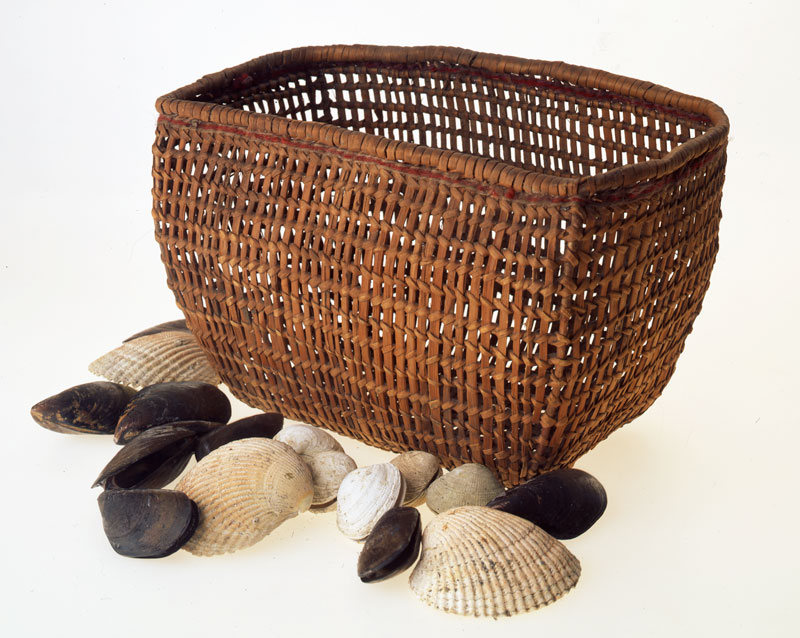
Nuuchahnulth peoples, Washington, pre-1898
Western red cedar (Thuja plicata), commercial wool, L 31 x W 7.5 x H 7.1 cm; 638-18
Open-worked baskets were used for everyday tasks such as carrying clams. Excess water drained easily from these sturdy baskets.
Where the Land Meets the Sea
At the western edge of Alaska, the forces of wind, waves, and currents, together with the runoff from the land, combine to form a dynamic, constantly changing, and demanding environment. This area is the most varied and richest of the Earth's environments, and it is also the most subject to change. The movements of the tides subject the plants and animals of the region to submersion in salty waters, exposure to air, cycles of drying and warming by the sun and wind, exposure to fresh water in rain, and the violence of Pacific storms.
Seemingly, an area of so many and such contrasting stresses would not be able to support an abundance of organisms; however, intertidal areas all over the world are teeming with rich and varied forms of life, many of them unlike anything found anywhere else. In fact, most of the Earth's life occurs at or near boundaries or convergences--between air and land or in the thin, phosphorescent layer of water at the surface of the oceans. Life is, indeed, a marginal affair.
